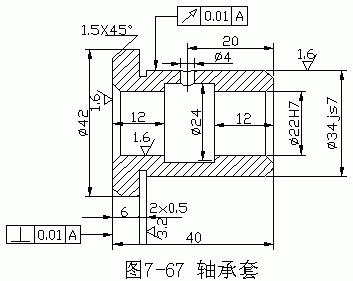The processing of sleeve parts varies according to their function, structural shape, material and heat treatment, and size. Divided by its structural shape, it can be roughly divided into two categories: short sleeve and long sleeve. They are very different in the processing and clamping methods, and are described separately below. (1) Analysis and processing of bearing sleeve processing technology    The bearing sleeve shown in Figure 7-67 is made of ZQSn6-6-3 and the quantity is 200 pieces per batch. 1. Technical condition and process analysis of bearing sleeve The bearing sleeve belongs to a short sleeve, and the material is a tin-clad figure 7-67 bearing sleeve sketch copper. The main technical requirements are: the radial circle runout tolerance of the outer circle of Φ34js7 to the Φ22H7 hole is 0.01mm; the vertical tolerance of the left end face to the axis of the Φ22H7 hole is 0.01mm. The outer circumference of the bearing sleeve is IT7 precision, and the precision car can meet the requirements; the inner hole precision is also IT7, and the reaming can meet the requirements. The processing order of the inner hole is: drilling - hole - reaming. Since the radial circular runout of the outer circle to the inner hole is required to be within 0.01 mm, clamping with a soft jaw cannot be guaranteed. Therefore, when the outer circle of the fine car is used, the inner hole should be used as the positioning reference, so that the bearing sleeve is positioned on the small taper mandrel, and the two top tips are used for clamping. This allows the machining reference to be consistent with the measurement basis and easily meets the drawing requirements. When the inner hole of the car is hinged, it should be machined with the end face in one clamping to ensure that the perpendicularity of the end face and the axis of the inner hole is within 0.01 mm. 2. Bearing sleeve processing technology Table 7-2 shows the machining process of the bearing sleeve. When roughing the outer circle, you can use five methods at the same time to increase productivity. Table 7-2 Processing process of bearing sleeve Serial number Process name Process content Positioning and clamping 1 Preparation 2 Drill center hole The other end of the head car, drill the center hole 3 Rough car 4 Drill 5 Car, hinge The inner hole 22H7 is Ф22 Reaming Ф22H7 to size 6 Finishing car 7 Drill 8 an examination Next page Expanded metal is a versatile and economical product made from a high-quality sheet of aluminum, steel, galvanized steel or stainless steel that is uniformly slit and stretched. This forms a diamond-shaped pattern of openings in the metal sheet. Expanded Metal,Aluminum Expanded Metal Mesh,Expanded Metal Sheet,Expanded Metal For Construction Hebei Aibuer trading co., Ltd , https://www.ablehardwares.com
I. Structural characteristics and process analysis of sleeve parts 
Bar material, processed in 5 pieces Car end face, drill center hole Three-jaw clip outer circle The outer round cymbal 42 has a length of 6.5mm, the outer round cymbal 34Js7 is Ф35mm, the empty sipe is 2×0.5mm, the total length is 40.5mm, the car split slot is 20×3mm, the two ends are chamfered 1.5×45°, and 5 pieces are processed together. , the same size Center hole Drilling Ф22H7 to Ф22mm into a single piece Soft claw clip Ф 42mm outer circle End face of the car, taking a total length of 40mm to size  Mm
Mm Soft claw clip Ф 42mm outer circle Rut 34Js7 (±0.012) mm to size Ф22H7 hole mandrel Drilling radial oil hole Ф 4mm Ф34mm outer circle and end face
Aluminum Expanded Metal Mesh is a type of expanded metal that is made from a sheet of aluminum. It is light, durable, and corrosion-resistant. This type of expanded metal is often used in architectural applications, such as window screens, room dividers, and decorative accents.
Expanded Metal Sheet is a broad term that refers to any type of expanded metal, regardless of the material from which it is made. These sheets are available in a variety of thicknesses and sizes, and they can be used for a wide range of applications, from industrial to decorative.
Expanded Metal for Construction is a type of expanded metal that is designed for use in construction applications. It is often used as a sturdy, lightweight material for walkways, ramps, and platforms. It can also be used as a reinforcement material in concrete and other construction projects. This type of expanded metal is typically more durable and has a higher load-bearing capacity than other types of expanded metal.